Blog Archives
November 10, 2003 
When Yogaswami began the publication in Jaffna, called the "Sivathondan" he would go to the press shop and watch the issue go to press and stayed quite close to the publication. Gurudeva began his mission in the early 50's in San Francisco with himself running a small Gestetner printing machine, ink all over his own hands. All through the years he continued to stay very close to the publications work. Here he is reading the pages of Hinduism Today before they go to press. He liked to have his computer voice activated and read to him the text at the same time. He once took a vrata to stay on Kauai for three years and worked every single afternoon, seven days a week with a few exceptions only for public obligations, to complete the editing of Merging with Siva.
Our Beloved and Revered Satguru Sivaya Subramuniyaswami
Attained Maha Samadhi on November 12th, 2001
Click to read for Details.
We are pleased to announce the web release of Satguru Sivaya Subramuniyaswami's monumental work on Hindu culture and lifestyle:
Living with Siva.
Click here for the entire text and artwork, now on-line!
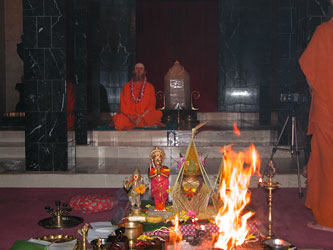
Bodhinatha seated for his Sun One Talk. Today he gave another version of his talk on Anger Management as part of the series of Ahimsa, wherein anger management is a critical factor in the control over violence.
Bodhinatha's Sun One Video. Most Recent update: September 12, 2003. Bodhinatha speaks on Ahimsa, noninjury, yama #1, which is noninjury in thought, word and deed. The law of karma decrees that it is wise not to harm or hurt others, for we will then receive harm and hurt in exchange in the future. 12 minutes, 29 seconds.
 |
|
|
|
Live Web Cam Pix! |
 |
||||
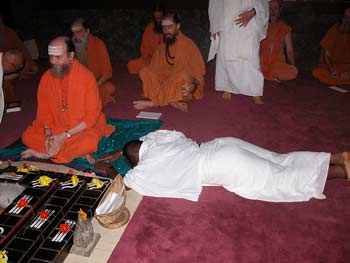
Thambynathan Girish Samugam is all settled in and merging beautifully with all the monks. He certainly has grown up to be a fine, concentrated young man. Here he is prostrating to Bodhinatha in the early morning hours.

Monks are quietly going within as the homa begins. One is practicing "Nada Suddhi" pranayama... cross-nostril breathing, a very traditional yoga practice and one which Gurudeva recommended.
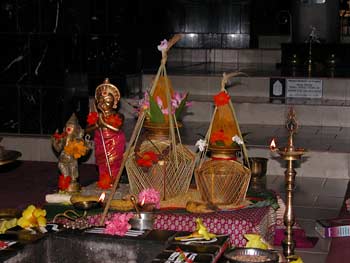
Two kumbhas, along with Lord Ganesha and Lord Hanuman arrayed before the homa fire.
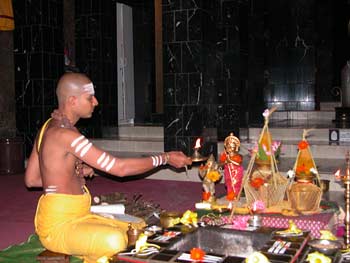
Yogi Mahadevan begins with an arati to Lord Ganesha.

In the back of the temple, at the Southwest corner of Kadavul stands the image of Ardhanarisvara, Half-female Lord. People often ask why we don't keep a "Shakti" deity in Kadavul. Well, Siva is both male and female, even Lord Nataraja has a male ear-ring and female ear-ring, and Gurudeva didn't want to perpetuate the idea of gender distinction with God, that there was Siva, a husband, and Shakti, a wife,... for such is not the case in the highest spiritual realms.
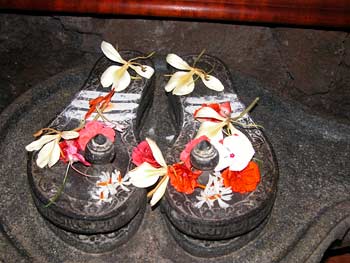
The sacred Paduka, Tiruvadi, sandals of Gurudeva at his shrine.
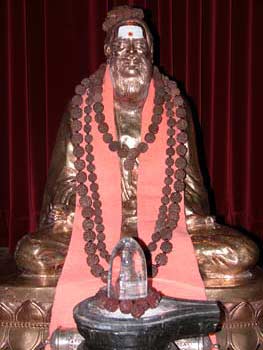
Gurudeva's murthi, laden with Rudrakshas.
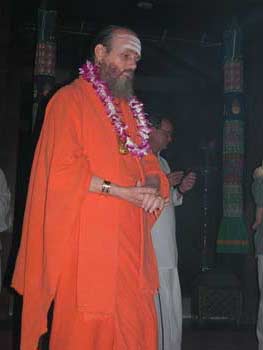
Bodhinatha stands for the final arati at the homa.
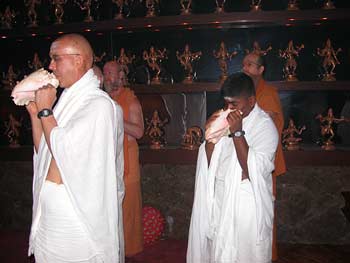
Sadhaka Adinatha blows the conch during the Arati and young Thambynathan Girish joins him.
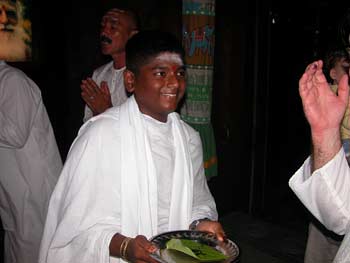
Thambynathan Girish passes on the prasadam from the homa.
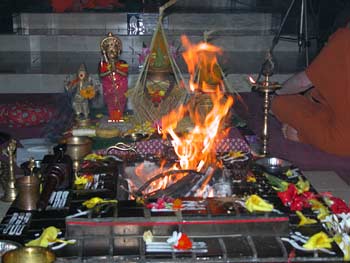
The fire continues to burn brightly as Bodhinatha goes up for his talk.
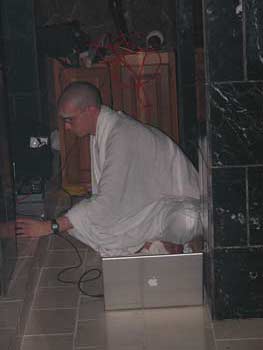
Sadhaka Jivanandanatha mans the audio equipment.

We are now using a wireless microphone for Bodhinatha... here is the "base station" (on the bottom) that receives the signal which is passed to a digitizing unit (on top) which sends the sound to the Mac via the USB port.

Incoming sound is then being recorded using Peak software that is "listening" to the USB port.
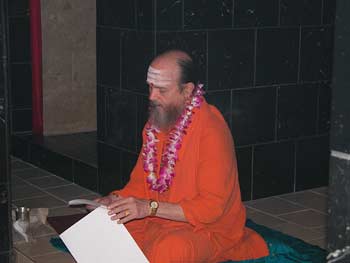
Bodhinatha read his precisely constructed talk on anger management.

A really big Hindu family joined us later in the morning.
![]()
Saiva Siddhanta Church
Golden Gate Mission
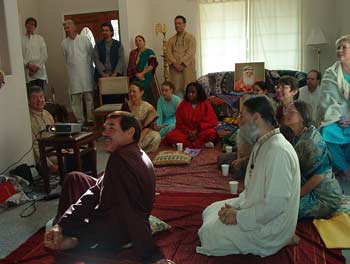
Easan Katir sends these photos. His son, Kartikeya is behind the camera, at the Golden Gate Mission satsang, November 9.
Here is everyone watching the powerpoint presentation "Hindu Heart".
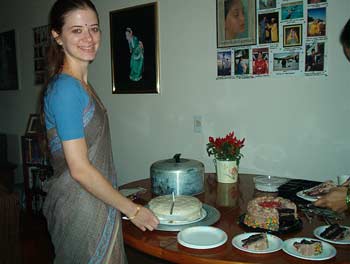
Devika Ajaya is enjoying her birthday celebration.
Happy Birthday Devika! We will all miss you when you go to Malaysia, but we know the Malaysia members will be gaining a big asset!
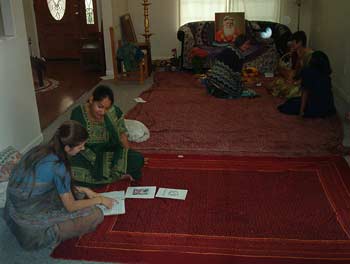
A quiet moment after satsang. Singers learning some new Natchintanai, and ladies chatting.
Bodhinatha gave an inspiring talk via telephone.Though a Naraka day, when the 5 lines to inner worlds are down, we did get a line to our Guru !

In the long TAKA tradition of colorful shots of nature, here are peppers fresh from the Rajan Gardens brought to satsang. Looking for something to help you meditate on the color Bright Red. Well here it is!

This unusual duck wondered into our courtyard during the retreat...seems to be looking at his friend in the mirror.

Today's Inspired Talk |
|
|
Title: Putting Gurudeva's Teachings to the Best Use, Part 4 Category: Self Improvement Duration: 7 minutes 31 seconds Date Given: October 23, 2003 Date Posted: November_10_2003 Given by: Bodhinatha |
|
For more information about listening to Gurudeva's talks online and to hear them in other formats, click here. And click here for an Index to All Past CyberTalks. Study Gurudeva's teachings
every day. Visit the Master Course site!
Bodhinatha will be happy to hold "Prasnottara Satsang" -- "Questions and Answers" over the telephone with any Hindu religious societies, Hindu youth groups, Radio talk show hosts etc. All you need is a phone with a speaker and an enthusiastic audience. Arrangements may be made in advance by sending email to Sannyasin Saravananathaswami If you are experiencing any problems listening to the audio, please to go our Audio FAQ page and follow the directions there.
| FULL INDEX OF 650+ CYBERTALKS
 |
|
Study Gurudeva's teachings.
|
transcription begins
Date: October_30_2003
Title: The Yama of Satya, Truthfulness
Category: Yamas and Niyamas
Duration: 7 min., 11 seconds
Date Given: September 20, 2003
Given by: Bodhinatha
We have a few more of the yamas and niyamas to record. This one is on yama number two, Truthfulness - Satya.
Today's lesson on 'Good Conduct' is on the second Yama of Satya, which is to adhere to truthfulness, refraining from lying and betraying promises. Speak only that which is true, kind, helpful and necessary. Knowing that deception creates distance, don't keep secrets from family or loved ones. Be fair, accurate and frank in discussions, a stranger to deceit. Admit your failings. Do not engage in slander, gossip or back biting. Do not bear false witness against another.
Let us look at some common examples of not following this Yama.
First example. At home, we are playing and knock a lamp over and it breaks. When our parents ask we deny knowing anything about it, as we fear how they would punish us.
Second example. In school, to get good grades rather than simply studying hard, we put our efforts into cleverly acquiring the test answers and if asked, of course, will tell a lie to cover up the dishonest act.
Third example. We are upset with our brother and to get back at him, make up a story. We tell our parents that our brother stole some tools from a neighbor.
Fourth example. We are salesmen and deliberately exaggerate the abilities of the products we sell, to increase our sales.
As our examples clearly show, Truthfulness and Honesty are quite interrelated. Satya - Truthfulness, together with the yama, Arjava - Honesty, are both focusing on harnessing the instinctive tendency to acquire more, to be more successful by not following the rules. The distinction between them is that Truthfulness relates to what we say, whereas Honesty relates to what we do. Clearly, to practice Truthfulness we also have to practice the yama, Honesty. For, if we are dishonest in our actions then this leads to being untruthful in our words. As we know, one lie usually requires another lie to cover it up and another one to cover up that one and before you know it, an intricate cover-up is in place that adds a layer of darkness to the subconscious mind, further distancing us from our soul nature.
Gurudeva describes three levels of non-truthfulness. The first level is when someone is in a state of fear and does not tell the truth to protect himself. Of course, a threatening environment where one fears physical punishment or even excessive non-physical punishment encourages someone to lie. You can't really blame a child for lying if he fears getting hit as a result of telling the truth. Therefore, the importance of a non-threatening environment is apparent for raising children who readily tell the truth.
The second level of non-truthfulness is deliberately lying about another, making up stories for the delight of getting that person in trouble. This relates to the Niyama of Santosha. If we are discontent, why not delight in making others suffer as well? However, if we are content then there is no motivation to get others in trouble.
A third and worst level of non-truthfulness is calculated deception and breaking of promises. Calculated deception can lead to dishonesty. We are trying to sell something to someone and we purposely misrepresent its value. Breaking of promises is when we tell someone we will definitely do something but we are not really committed to doing it. Someone shares a secret with us and asks us not to tell anyone else. We say yes but are not really committed to keeping it confidential.
There are two subtleties to the Yama of Truthfulness both nicely expressed in the Tirukural's chapter 30, 'Truthfulness'.
Verse one reads, "What is truthfulness? It is speaking words which are totally free from harmful effects."
The subtle point here is that Truthfulness should never cause unnecessary hurt. For example, telling someone he is really fat is the truth but will probably hurt the person's feelings unnecessarily. If we need to say anything at all, it should be gentle, such as, "You might benefit from losing some weight."
The second verse in the Kural's chapter on 'Truthfulness' voices the second subtle point. "Even falsehood is of the nature of truth, if it renders good results free from fault."
This subtlety comes up in such professional capacities as an astrologer or doctor. An astrologer is not supposed to speak out every negative aspect of a chart, as it would be too discouraging. So he would leave out or lessen some parts. Likewise, a doctor would not automatically tell every problem to a patient, as it could discourage the patient too much and lead to severe depression.
Another aspect of Truthfulness is that there are significant differences between the worlds' cultures and how they look at truthfulness. We need to refrain from projecting our own cultural upbringing on others.
For example. In one culture, "Yes" will definitely mean "Yes", while in another it will be a polite form of "No." In one culture, a business contract once made is never re-negotiated, while in another it is constantly re-negotiated.
So don't be too quick to judge others as being untruthful, as it may just be they were raised up with a different cultural concept of what truthfulness is, than you were.
In conclusion: Adhere to Truthfulness, refraining from lying and betraying promises. Speak only that which is true, kind, helpful and necessary. Knowing that deception creates distance, don't keep secrets from family or loved ones. Be fair, accurate and frank in discussion. A stranger to deceit, admit your failings. Do not engage in slander, gossip or backbiting. Do not bear false witness against another.
Aum Namah Sivaya.
transcription ends
|
MORE UPLIFTING THINGS |
2004 Indian Odyssey
Join Satguru Bodhinatha Veylanswami on an 18 day Innersearch to South India, from Jan 19 to Feb 5, as we pilgrimage to ancient monasteries, magnificent 1,000 plus year old sacred temples and meet with India's holy men in a life-transforming adventure. Click on the above link for more details. |
|

|
Check our children and youth section for new items for the young and young at heart! | |
|
1. SIGN OUR GUESTBOOK and receive a FREE GIFT |
||
| 2. Newest Book: LIVING WITH SIVA | ||
|
3. Visiting KAUAI'S HINDU MONASTERY |
||
|
4. Contribute to THANK YOU, GURUDEVA FUND |
||